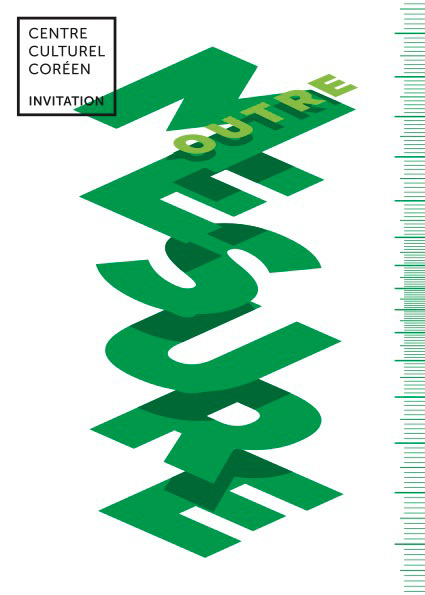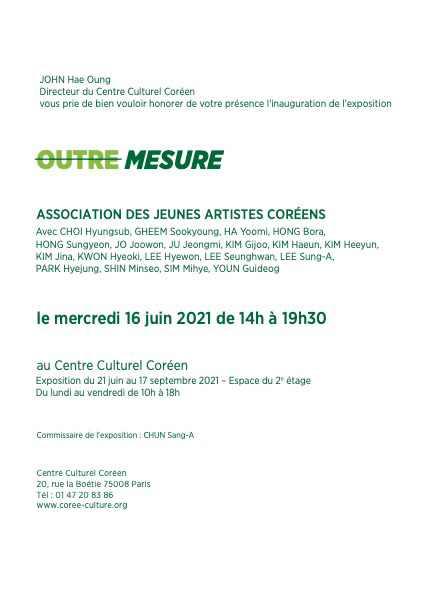Centre Culturel Coréen, Espace d’exposition 2
20 Rue la Boétie 75008 Paris, France
Archivage de mes mémoires #1990_1, 2021, Mixed media and Korean paper collage on canvas, 73 x 92 cm
Archivage de mes mémoires #1990, Mixed media and Korean paper collage on canvas, 12.5 x 18 cm
My works address a variety of topics, but ultimately, they all come together around one theme: communication. For me, art has always been a means of communication, art was communication. Art creates a link between individuals, between dreams and reality, desire and moderation, and finally, between the present and the future. I participated in this exhibition “Outre Mesure” by interpreting the concept as something that exists beyond the limit and boundary. I tried to communicate with the public while breaking the expression barriers I had acquired during my childhood. For this, I was inspired by the most intimate stories of my life.
Through “Outre Mesure”, I allowed the human nature of forgetting and the desire to protect our fragile memories to merge. When I develop a project, I am often inspired by everyday life. Most of the time, I focus on my new identity as a foreign artist and my old identity, which I am gradually losing since I arrived in France. I try to recreate this duality on the canvas. However, for this new project, I decided to take a step back and revisit the past. My parents have forgotten many memories of my childhood. Apparently, there are things that disappear more quietly than we can imagine, without any sound.
Here’s what my parents tell me today: “Oh really? I don’t remember.”
Memories are powerless. It’s sad that these memories lose their way and end up dying in our small brains, without any trace. And in the end, it is we who kill them. That’s why I decided to mark the trace of my memories on the canvas. It is certain that there are landscapes that no longer exist. And I don’t even know which color to choose to color these forgotten places. But I know it’s the only way to find the path to return to my homeland.
Memories are powerless. It’s sad that these memories lose their way and end up dying in our small brains, without any trace. And in the end, it is we who kill them. That’s why I decided to mark the trace of my memories on the canvas. It is certain that there are landscapes that no longer exist. And I don’t even know which color to choose to color these forgotten places. But I know it’s the only way to find the path to return to my homeland.
Since coming to France, I’ve had many questions about my identity as a foreigner. Because living abroad also means forgetting a large part of our origins to build a new life. And today, I am ready to communicate with my past through art in order to cross this boundary.
“Outre Mesure”에서는 잊혀지고 잊혀질 수 밖에 없는 것과 그것들을 지키고 싶은 욕망의 경계를 허물고 공존시키는 작업을 진행하였습니다. 저는 작업을 할 때, 제 일상 생활에서 많은 소재를 얻고 있어요. 해외에서 살면서 제 정체성과 있어야 할 장소는 어디인가 대한 고민과 작업이 주를 이뤘습니다. 하지만 이번 작업에서는 요즘 들어 계속 마음 한 구석에서 깜박이는 예전의 추억들을 캔버스 위에 풀어내었어요.
늦은 밤에 침대에 누우면 생각이 나면서 가슴이 아련한 그런 것들 있잖아요. 하루는 부모님께 제 어릴 적 기억을 말한 적이 있어요. 그런데 부모님께서는 "우리가 그런 적이 있었나?"하고 기억이 안나신데요. 아직도 저는 서로 웃고 떠들 던 순간이 선명하거든요.
그 때 문득 든 생각이 내가 나중에 부모님처럼 잊어버리면 우리들의 소중한 시간은 영원히 사장된다는 것이었습니다. 이미 지나간 시간이지만 우리 머릿 속에서 살아있는 것이잖아요. 그것들이 잊혀졌을 때 완전히 지나간 시간이되고 죽음을 맞이한다는 사실이 너무 슬펐어요. 그리고 그것을 죽이는 주체가 저라는 사실도요. 그래서 저는 잊고 싶지 않은 모든 순간들을 캔버스 위에 남기고 있습니다. 아직도 존재하는지 아닌지도 모를 장소를 그리다 보니 색이 선명치않고 확실하지 않습니다. 하지만 자세히 보지 않으면 지나칠 이야기들이 확실히 각인되어 있습니다.
저와 연결된 모든 사람들과의 순간들이 어떠한 형태로라도 잊혀지지않고 남아있기를 바라며...
June 2021 in Paris
Journal written on the canvas
In 1990, before the construction of Incheon International Airport, there was a huge reed bed on Yeongjong-do. With my whole family, we often went there in my mother’s tiny red “Tico” car. At that time, we lived in Anyang, about an hour and a half away by car. I would fall asleep easily in the car, and my father would wake me up. My father would take the mat, my mother the lunch basket, I would take the fishing rods, and my little brother would go empty-handed. It’s a memory I miss. My mother would accompany me to fish, but she didn’t like earthworms. And I wanted to scare her. I gave her the little matchbox in which I had hidden the earthworms.
“What’s this?”
My mother asked.
My mother asked.
“I don’t know. Open it!”
I pretended not to know.
“No!”
“Hahaha.”
I laughed a lot. Luckily, she didn’t hit me. While my mother complained, I walked along the mudflat. At that time, there were many fish called ‘gobies.’ (I think they’re still there.) These gobies can breathe for a long time even outside of water. And they can move using their fins. They have frog-like eyes. They are very ugly.
My grandmother also fished for gobies. She would dry them in the garden and then make me taste them with fermented red chili sauce. The taste was special. And this taste made me love fishing. I spent part of my childhood collecting gobies and shells in that mudflat.
In the mudflat, there were crabs, small shells, and fish. I remember seeing little holes on the beach. If the hole was small, there had to be a shell. If the sand was piled around a hole, there might be a crab living in it. I would dig the sand with a spoon. Sometimes, the shells would spit out water before running away. The crabs would show their pincers to threaten me. To fish for gobies, all you had to do was cast a rod. After the hunt, the whole family would return to the mat to watch the sunset on the beach.

